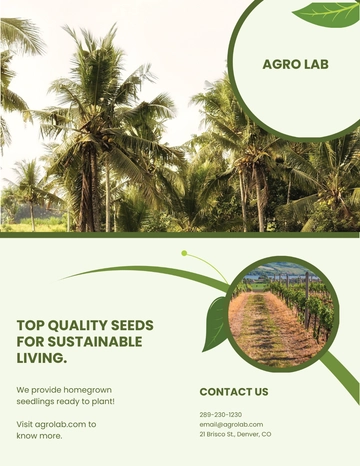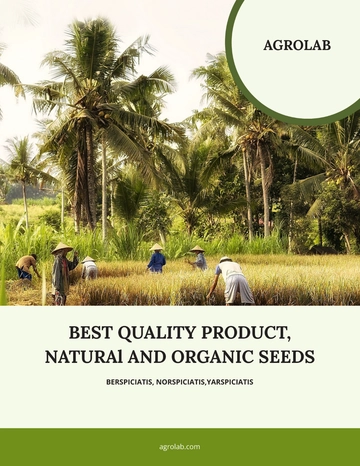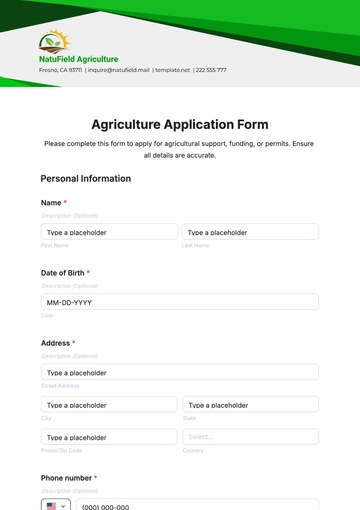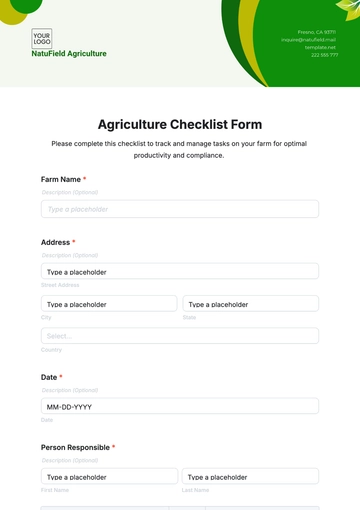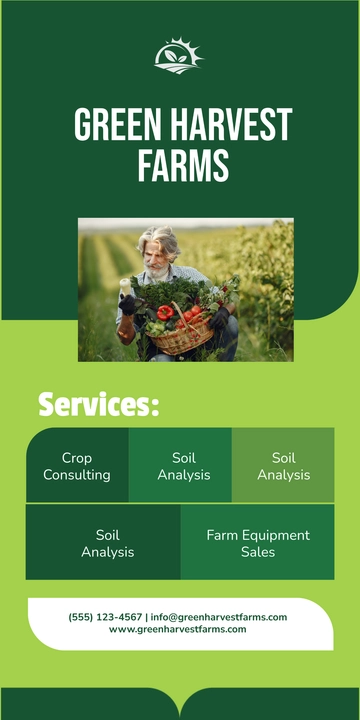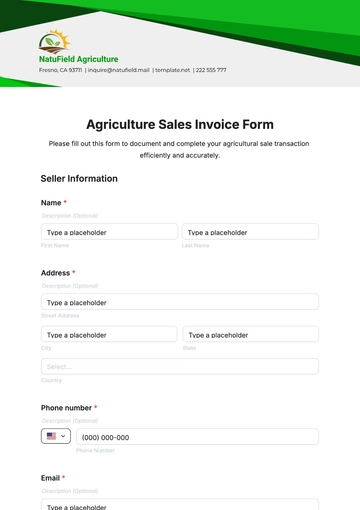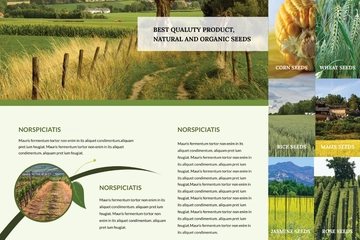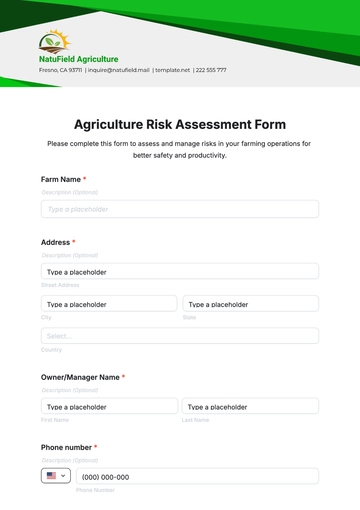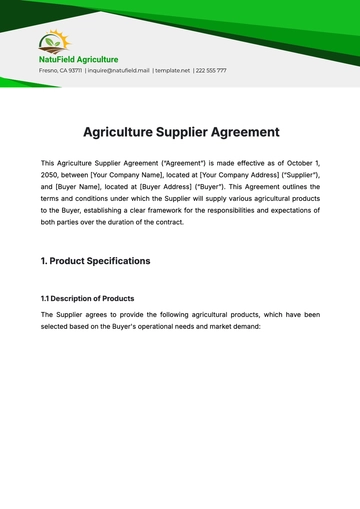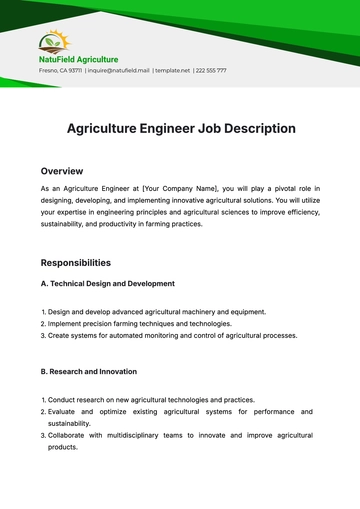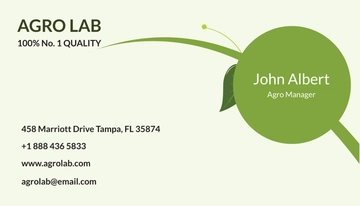Free Agriculture Workforce Planning Feasibility Study

I. Executive Summary
This feasibility study conducted by [Your Company Name] explores the potential for developing a comprehensive workforce planning initiative tailored to the agriculture sector. As the agricultural industry faces increasing challenges related to labor shortages, skill gaps, and seasonal workforce fluctuations, this study evaluates the current market demand for agricultural workers, assesses the financial feasibility of proposed solutions, and examines relevant legal and operational considerations. The research includes a detailed analysis of the agricultural labor market, including trends in workforce availability, the impact of technology and automation, and the effectiveness of existing workforce strategies. Additionally, it explores financial projections for potential investments in workforce development programs and identifies regulatory requirements for compliance.
The findings of this study reveal a significant opportunity for [Your Company Name] to implement a strategic workforce planning framework that addresses key issues such as recruitment, training, and retention of agricultural employees. By leveraging innovative approaches and aligning with industry best practices, the proposed initiative aims to enhance labor efficiency, support sustainable growth, and improve overall workforce management in agriculture. The recommendations highlight actionable steps for establishing a successful workforce planning strategy, ensuring long-term benefits for both agricultural enterprises and the broader agricultural community.
II. Project Description
The project proposed by [Your Company Name] aims to address critical challenges within the agricultural sector by developing a robust workforce planning initiative. This initiative is designed to enhance workforce allocation efficiency, manage labor costs, and mitigate labor shortages, particularly during peak agricultural seasons. The project’s goals are aligned with the current needs of the agricultural industry, which faces persistent issues related to labor availability, cost control, and operational efficiency. Through a systematic approach, this project seeks to create a framework that not only addresses these immediate challenges but also supports long-term growth and stability in the sector.
Objectives
The primary objectives of the workforce planning initiative are threefold:
Enhance Workforce Allocation Efficiency
The first objective focuses on optimizing workforce allocation to ensure that labor resources are used effectively across various agricultural operations. This involves developing strategies to match labor supply with demand, streamline scheduling processes, and utilize technology to forecast workforce needs. By improving allocation efficiency, [Your Company Name] aims to reduce idle time, increase productivity, and ensure that labor resources are deployed where they are most needed.
Reduce Labor Shortages in Peak Seasons
Addressing labor shortages during peak agricultural periods is a key goal of the initiative. This objective includes creating flexible staffing solutions, such as seasonal hiring programs and partnerships with labor agencies, to ensure that the workforce is adequate during high-demand times. By implementing these solutions, [Your Company Name] intends to minimize the impact of labor shortages on agricultural productivity and operations.
Improve Labor Cost Management
The final objective is to develop effective labor cost management practices. This includes analyzing current labor expenses, identifying cost-saving opportunities, and implementing strategies to manage wages, benefits, and overtime costs. The goal is to achieve a balance between controlling labor costs and maintaining a motivated, well-compensated workforce.
Through these objectives, [Your Company Name] aims to create a sustainable and efficient workforce planning model that meets the current and future needs of the agricultural sector.
III. Market Analysis
The agricultural labor market is experiencing significant transformations driven by evolving industry demands, technological advancements, and shifting workforce demographics. This market analysis explores these dynamics to provide a comprehensive understanding of the current state of the agricultural workforce and identify opportunities for strategic workforce planning initiatives by [Your Company Name].
Current Trends
One prominent trend is the increasing reliance on technology and automation within agriculture. Innovations such as autonomous tractors, precision agriculture, and advanced irrigation systems are reshaping traditional farming practices. While these technologies promise enhanced efficiency and productivity, they also necessitate a shift in workforce skills. There is a growing need for workers with technical expertise to manage and maintain these advanced systems, highlighting a gap between current workforce skills and future requirements.
Another trend is the increasing prevalence of seasonal labor shortages. Agricultural operations often experience peak periods during planting and harvest seasons, leading to fluctuations in labor demand. These shortages can impact productivity and operational efficiency, underscoring the need for flexible workforce solutions such as temporary staffing arrangements and streamlined recruitment processes.
Challenges and Opportunities
Challenges | Opportunities |
|---|---|
|
|
Addressing these challenges through strategic workforce planning can provide significant benefits, such as increased productivity, reduced labor costs, and improved operational efficiency. By capitalizing on the opportunities presented by technological advancements and addressing seasonal labor issues, [Your Company Name] can position itself as a leader in innovative workforce solutions within the agricultural sector.
IV. Financial Feasibility
The Financial Feasibility section evaluates the economic aspects of implementing the proposed workforce planning initiative for [Your Company Name]. This analysis assesses the initial setup costs, ongoing annual operating expenses, and projected revenues to determine the overall financial viability of the project. By examining these financial components, we aim to provide a clear picture of the investment required and the potential financial returns. This section offers insights into whether the benefits of the proposed workforce planning solutions justify the costs and how they align with [Your Company Name]’s long-term financial goals.
Item | Cost |
|---|---|
Initial Setup Costs | $[0] |
Annual Operating Costs | $[0] |
Projected Annual Revenue | $[0] |
Return on Investment (ROI) | [0]% |
The Financial Feasibility analysis reveals whether the initial investment in workforce planning and ongoing operational costs are justified by the anticipated financial returns. By comparing the projected annual revenue against the setup and operating expenses, we can assess the potential for a positive return on investment. A favorable ROI indicates that the workforce planning initiative will not only cover its costs but also generate value for [Your Company Name]. This section’s findings help determine if the proposed solutions are financially sustainable and align with the company’s strategic objectives.
V. Legal Considerations
In developing a comprehensive workforce planning initiative for [Your Company Name], it is essential to address various legal considerations to ensure compliance with federal, state, and local regulations. This section outlines key legal requirements and potential legal issues related to workforce management in the agricultural sector, providing a foundation for developing a legally sound and effective workforce planning strategy.
Federal and State Regulations
Fair Labor Standards Act (FLSA)
The FLSA establishes minimum wage, overtime pay, and recordkeeping requirements for employees. It is crucial for [Your Company Name] to adhere to these regulations to avoid legal disputes and ensure fair compensation for agricultural workers. Understanding the distinctions between exempt and non-exempt employees under the FLSA, especially for seasonal workers, is essential for compliance.
Occupational Safety and Health Administration (OSHA) Regulations
OSHA regulations mandate safety standards in the workplace to protect employees from health and safety hazards. [Your Company Name] must ensure that all agricultural operations meet OSHA’s safety requirements, including proper training, hazard communication, and protective equipment for workers.
Immigration and Nationality Act (INA)
The INA governs the employment of non-citizens and requires employers to verify the eligibility of employees to work in the United States. [Your Company Name] must comply with the INA by maintaining accurate Form I-9 documentation and ensuring that all employees are legally authorized to work.
State-Specific Labor Laws
States may have additional labor laws that affect agricultural workers, such as regulations on agricultural wages, workers’ compensation, and family leave policies. [Your Company Name] should review state-specific requirements to ensure compliance with all applicable laws and avoid legal issues.
Legal Risks and Mitigation
Legal Risks | Mitigation Strategies |
|---|---|
|
|
VI. Operational Feasibility
The Operational Feasibility section assesses whether [Your Company Name] can effectively implement the proposed workforce planning initiative. This evaluation considers the practical aspects of executing the project, including resource requirements, potential challenges, and the strategies for overcoming these challenges. The goal is to determine if the initiative is operationally viable and if the necessary resources and processes are in place to support its success.
Key Operational Considerations
Resource Requirements
Successful implementation of the workforce planning initiative requires adequate resources, including financial investment, skilled personnel, and technological tools. [Your Company Name] must allocate budget for initial setup costs, including recruitment, training programs, and technology investments. Additionally, the company needs to ensure that there are qualified staff members to manage the initiative, including project managers and HR professionals with expertise in agricultural labor issues.
Process Development
Establishing effective processes for workforce planning involves creating structured workflows for recruitment, training, and performance management. This includes developing standard operating procedures (SOPs) for hiring practices, creating training modules for new technologies, and setting up performance evaluation systems. Clear documentation and consistent application of these processes are essential for maintaining operational efficiency.
Technology Integration
The initiative will involve the integration of new technologies such as workforce management software and data analytics tools. [Your Company Name] must ensure that these technologies are compatible with existing systems and that employees are trained to use them effectively.
Operational Challenges and Solutions
Challenge | Solution |
|---|---|
Resource Allocation | Develop a detailed budget plan and timeline for resource allocation, ensuring that all necessary investments are made efficiently. |
Process Implementation | Create comprehensive SOPs and provide training for staff to ensure consistent implementation of workforce planning processes. |
Technology Adoption | Invest in user-friendly technology solutions and offer training sessions to help employees adapt to new tools and systems. |
VII. Risks
The Risks section identifies potential challenges associated with implementing the workforce planning initiative for [Your Company Name] and proposes strategies to mitigate these risks. Understanding and preparing for these risks are essential for ensuring the project’s success and achieving desired outcomes.
Potential Risks and Mitigation Strategies
Risk | Description | Mitigation Strategy |
|---|---|---|
Labor Shortages | Difficulty in finding qualified workers for agricultural positions. | Develop strong recruitment channels, including partnerships with local educational institutions and labor agencies, and offer competitive wages and benefits. |
High Turnover Rates | High employee turnover affecting project stability. | Implement comprehensive training programs and career development opportunities to enhance employee satisfaction and retention. |
Technological Challenges | Issues with the adoption and integration of new technologies. | Select user-friendly technologies, provide thorough training, and offer technical support for smooth implementation. |
Regulatory Compliance Issues | Non-compliance with legal regulations. | Conduct regular audits, stay updated on legal requirements, and seek legal counsel to ensure adherence to federal and state laws. |
VIII. Recommendations
Based on the comprehensive analysis of market conditions, financial viability, legal considerations, and operational feasibility, it is recommended that [Your Company Name] proceed with the workforce planning initiative. This project presents a promising opportunity to address the prevalent labor challenges within the agriculture sector.
Key Recommendations
Develop and implement comprehensive training programs to upskill the workforce for new technologies and methodologies.
Create flexible staffing solutions to manage seasonal labor demands and reduce turnover.
Invest in technology for effective workforce management and data-driven decision-making.
Ensure legal compliance through regular audits and expert legal counsel.
By following these recommendations, [Your Company Name] can enhance workforce efficiency, reduce operational challenges, and position itself for future success in the agriculture sector.
- 100% Customizable, free editor
- Access 1 Million+ Templates, photo’s & graphics
- Download or share as a template
- Click and replace photos, graphics, text, backgrounds
- Resize, crop, AI write & more
- Access advanced editor
Optimize your labor strategy with Template.net’s editable and customizable Agriculture Workforce Planning Feasibility Study Template. Editable in our Ai Editor Tool, this template helps you assess the feasibility of workforce plans, ensuring effective resource allocation and strategic planning for your agricultural operations.
